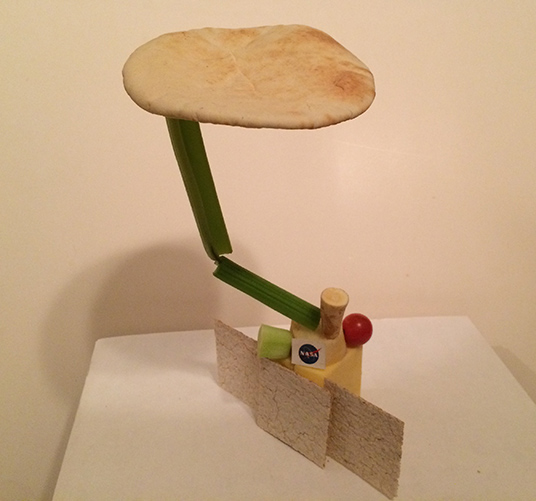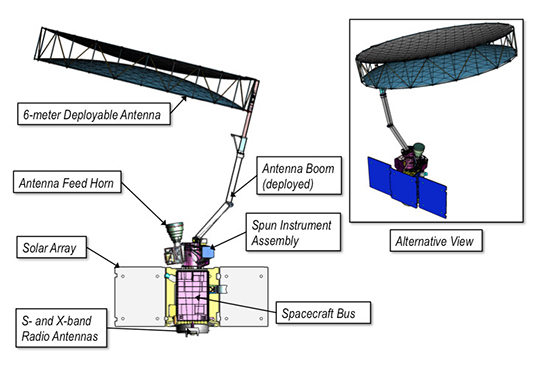Ask NASA Climate | January 26, 2015, 15:22 PST
Pita bread! What was I thinking?

Pictured here is my edible SMAP (Soil Moisture Active Passive) model.
Every time I make one of these edible satellite models, I go through a crisis phase. I feel horror, worry, shame.
“This looks absolutely hideous!” I fret. “People who read this blog will think I’m nuts.” (Which I am, btw, just sayin'.) So far, my mini-meltdown around constructing the edible version of NASA’s Soil Moisture Active Passive (SMAP) observatory was worse than the other four edible models I’ve made. I mean, just look at it! Pita bread? Really? What was I thinking? It took teams of engineers with decades of experience to design and build the new technology on SMAP, and I sat alone in my kitchen with a celery stalk.
SMAP is the final of five NASA Earth science satellites launched within a 12-month span. It uses a radar, which is active, and a radiometer, which is passive, to make its measurements, thus the name. But it’s the innovative rotating antenna on an extended boom that made both the actual and the edible instruments such a challenge to build.
While NASA has many instruments with rotating antenna—RapidScat, for example, is an instrument that was deployed onto the International Space Station earlier this year—the SMAP antenna is unique and experimental. (I wanted to call it “ground”-breaking, but not when it’s on a rocket nose cone headed for space.) Its size makes it possible to achieve greater accuracy over a larger area than any other type of antenna. Plus—come on—once deployed, it will be a 20-foot (6-meter) gyroscope spinning in space, orbiting our Earth.
Yowsa! That’s just hella cah-ray-zy!
Oh yeah, and the antenna? It’s made of gold. That’s right, people, you heard me: gold. Can I hear you say “Bling”?
All right now, let's get back to the pita bread. This was, by far, the trickiest of the edible models to build, because the arm—made of celery—had to support the weight of the antenna—pita bread. My challenge was only a small “taste” of what the engineers who designed the instrument had to face. The actual SMAP antenna was built to function in the minimal gravity of space rather than the gravity on the ground, which meant there was a limited amount of testing done with the antenna opened.
As with the other edible models, building this one forced me to look closely at the design and, therefore, learn about the instrument. I encourage you to try it, too. The spacecraft bus is white cheddar; the solar array is thin crackers; the spun assembly is made of yam, cherry tomato and broccoli stalk; and the antenna feed horn is a parsnip.

After I finished taking photos of my masterpiece, I ate it—all of it. And the cheese and crackers went really well with the glass of wine that eased me down from my crisis of shame.
Go ahead: Make your own NASA SMAP model, and share your photos in the comments section. You can learn more about the instrument here, here and here.
Also, check out my edible CATS, GPM, OCO-2 and ISS-RapidScat models.
I look forward to your comments and creativity.
Laura
SMAP is part of NASA's Earth Right Now campaign, a series of five Earth science missions that will be launched into space in the same year, opening new and improved remote eyes to monitor our changing planet.
